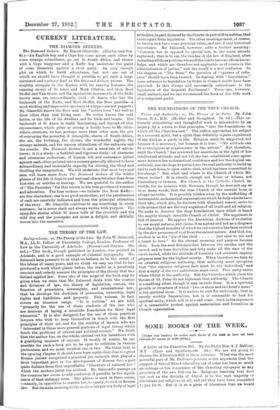THE FOUNDATIONS OF THE TRUE CHURCH.
Vision and Authority ; or, The Throne of St. Peter. By John Oman, M.A., B.D. (Hodder and Stoughton. 75. 6d.)—This ex- tremely stimulating and thoughtful work is intended to be an inquiry, by a return to first principles, "into the foundations on which all the Churches rest." The author approaches his subject in a reverent spirit, but a spirit that definitely rejects expediency of any kind as a guide in life. Religion must be supported, not because it is necessary, but because it is true. "No attitude can be so irreligious as acquiescence in the untrue." Not, therefore, until the Church "has reviewed her assertions in the light of her intellectual attitude, and not till she has established some agree- ment between her ecclesiastical confidence and her theological un- certainty, can she hope to put in force the real authority to build up and to cast down, to open and to shut, which has been committed to her charge." But what and where is the Church of which Mr. Oman writes ? It is clearly enough not Rome or Athens, not Canterbury or Geneva. His Church is the Catholic Church in- visible, for he believes with Newman, though he does not say so in so many words, that the true Church of the current hour is always invisible. It is possibly hidden away by the scaffolding of innumerable ecclesiastical organisations which he fully admits have their uses, which also, he declares with abundant reason, serve to hide abuses that are the very negation of all truth and all religion. He seeks to discover the deep foundations upon which is based the mighty though invisible Church of Christ. The argument is full of interest. Ho applies the Darwinian doctrine of evolution to our moral natures, and claims it as a glory and not as a disgrace that the highest morality of which we can conceive has been evolved by the slow processes of God from the animal nature. And God, too,
evolves in us the "joy of the ideal just eyes to see and a heart to love." So the eternal meaning and purpose become clear. Soon the soul distinguishes between the secular and the sacred, and in time discipline and duty make all the uses of the earth sacred, while the attitude of humility and reverent inquiry prepares man for the highest secrets. When therefore we turn to an external religious authority, that authority must recognise that "the supreme religious fact must be the individual," and that a unity of the two authorities must exist. This unity exists where Christ is the authority. But the Churches which claim the throne of St. Peter do not represent that authority. The Church is something other, though it may include them. It is a spiritual growth or structure of which "two or three met in Christ's name" is the spiritual atom. It is useless to seek for uniformity, that is, merely worldly Imperialism, but it is reasonable to look for spiritual unity, which will in the end come. Such is the argument of a remarkable protest against materialism and formalism in Church organisation.






































 Previous page
Previous page